Public investments in child care assistance bolster economic opportunity by helping Georgia parents maintain stable employment while promising better health, educational and economic outcomes for young children.
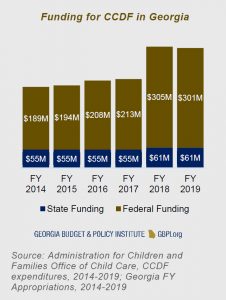 Families with low incomes can qualify for child care assistance through the federal and state funded Childcare and Parent Services (CAPS) subsidy program, but not all get the support they need. Federal Child Care Development Fund (CCDF) dollars, which make up the bulk of the program’s funding, have historically remained fixed at a level that does not allow all families who may be eligible to participate. Only one in seven potentially income-eligible Georgia children ages 12 and under participate in the program.[1]
Families with low incomes can qualify for child care assistance through the federal and state funded Childcare and Parent Services (CAPS) subsidy program, but not all get the support they need. Federal Child Care Development Fund (CCDF) dollars, which make up the bulk of the program’s funding, have historically remained fixed at a level that does not allow all families who may be eligible to participate. Only one in seven potentially income-eligible Georgia children ages 12 and under participate in the program.[1]
In 2018, Georgia’s Department of Early Care and Learning (DECAL) received a historic boost in funding from CCDF in the amount of $93 million.[2] On track to obligate all the funds by September 2019 and spend the funds by September 2020, the agency committed to deploy the resources as follows[3]:
- Increase reimbursement rates for infants and toddlers and increase the tier bonuses for quality-rated child care providers ($33.8 million)
- Significantly reduce family co-payments ($21.8 million)
- Increase affordable child care slots through Quality-Rated Subsidy Grants ($22.5 million)
- Increase support staff to meet the social and emotional health needs of children ($2.8 million)
- Expand financial support for early learning workforce development ($9 million)
- Eliminate the costs of background records checks ($3.5 million)
While these steps are crucial for building the supply of quality providers and lowering the cost of child care for existing CAPS families, bold and permanent increases in state and federal funding are needed to help Georgia reach hundreds of thousands of additional income-eligible families.
New Federal Funds Focus on Improved Quality, Access
Higher Reimbursement Rates ($33.8 million)
Georgia’s CAPS program helps parents afford childcare by making direct payments to providers in the form of reimbursement. With new federal funding, Georgia is increasing the supply of affordable child care providers by raising the weekly base reimbursement rate for infant and toddler care to the 25th percentile of rates listed in Georgia’s 2017 Child Care Market Rate Survey.[4]
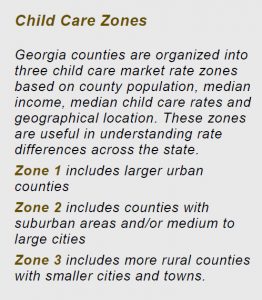 DECAL is also increasing the bonus reimbursement rates to 10, 20, and 40 percent of the payment rate for child care providers that are one, two, or three-star Quality Rated[5], respectively.[6] This is an increase from the previous rates of 5, 10, and 25 percent. In Zones 2 and 3, the weekly bonus reimbursement rate for three-star rated programs exceeds the 75th percentile of rates in the 2017 Market Rate Survey. This important increase supports providers that are committed to raising quality and helps DECAL ensure that all eligible providers serving CAPS families earn a star-rating by December 31, 2020.[7]
DECAL is also increasing the bonus reimbursement rates to 10, 20, and 40 percent of the payment rate for child care providers that are one, two, or three-star Quality Rated[5], respectively.[6] This is an increase from the previous rates of 5, 10, and 25 percent. In Zones 2 and 3, the weekly bonus reimbursement rate for three-star rated programs exceeds the 75th percentile of rates in the 2017 Market Rate Survey. This important increase supports providers that are committed to raising quality and helps DECAL ensure that all eligible providers serving CAPS families earn a star-rating by December 31, 2020.[7]
The base reimbursement rate in Georgia’s child care assistance program is an average of $147 per week for full day care for an infant or toddler in metro Atlanta, or Zone 1.[8] The rates for Quality Rated and non-Quality Rated licensed centers in Zone 1, where child care is the most expensive, remains lower than the 75th percentile of market rates. Reimbursement rates at the 75th percentile of market rates for child care are ideal and recommended by CCDF. With additional state and federal funds, Georgia could set rates at the 75th percentile for all eligible providers and ensure CAPS families have access to at least three-quarters of all available child care that participate in the CAPS program.[9]
 Reduced Family Co-Pays for CAPS Families ($21.8 million)
Reduced Family Co-Pays for CAPS Families ($21.8 million)
Georgia families must share in the cost of child care to qualify for a subsidy. Families pay a weekly fee, or co-pay, directly to their child care providers. The fee is based on family size, income level, and the number of children in care.
Prior to new CCDF funding, some families paid as high as 26 percent of their income in co-pays.[10] DECAL is deploying $21.8 million in new CCDBG funds to reduce the co-pay and ensure families never pay more than seven percent of their income for child care. Some eligible families could pay as little as zero percent. This change helps Georgia satisfy the federal government’s recommendation to ensure families who receive assistance never pay a greater share of their income on child care than the national average.[11]
Quality Rated Subsidy Grants ($22.5 million)
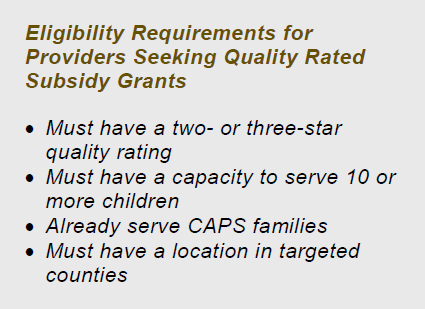 Under current law, states may contract with child care providers to provide greater access to quality and affordable child care. Georgia’s Quality Rated Subsidy Grants (QRSG) allow more high quality child care centers to expand their capacity to serve CAPS-eligible families.
Under current law, states may contract with child care providers to provide greater access to quality and affordable child care. Georgia’s Quality Rated Subsidy Grants (QRSG) allow more high quality child care centers to expand their capacity to serve CAPS-eligible families.
With $21.5 million in new funds, DECAL has added 500 QRSG seats to current and new providers that meet specific criteria. This raises the number of quality-rated grant slots to 3,000 from 2,500. Child care providers participating in the QRSG program will also be reimbursed 50 percent above the base rate for their zone, an increase from 35 percent in prior years.[12]
Early Childhood Social and Emotional Health ($2.8 million)
DECAL’s Inclusion Specialists are responsible for providing support for children with disabilities and their families. Through direct partnerships with child care providers, specialists provide technical assistance to remove barriers to inclusion in child care settings for children with physical and behavioral challenges.
DECAL allocated $2.8 million of the new funds to support enhanced inclusion services with a specific focus on the social and emotional health of children. The funds allow Georgia to hire additional inclusion and behavior support specialists across Georgia. DECAL is also developing a centralized intake process that will route concerns about a child’s behavior to the appropriate support staff. With these new resources, the Department will reduce the number of cases of young children being suspended or expelled from child care programs.
Expand financial support for early learning professional development ($9 million)
To build a stronger workforce of early learning professionals, DECAL is using $9 million in new funding to provide enhanced financial support for workforce development. Through bonuses and stipends, DECAL is supporting professionals to obtain advanced credentials and degrees, with a particular focus on teachers that work in bilingual settings, infant-toddler care and family child care. The agency is also building a model career pathway program for high school students that are interested in careers in early childhood education. New funds will cover 100 percent of the costs for the application required to obtain child development certification, which costs $425.
No-Cost Comprehensive Records Checks ($3.5 million)
Individuals working in license-exempt programs that receive CAPS subsidies or working in licensed child care programs must undergo a comprehensive background check and obtain a satisfactory determination from DECAL.
With $3.5 million in new funds, DECAL has agreed to cover the cost of the initial background check for all eligible child care workers for the next two years. This includes new hires to the industry and/or those whose current comprehensive records check determination letter is about to expire. DECAL ensures that all employees working in child care undergo and pass a thorough background evaluation while providing a safe environment for Georgia’s children in child care. By funding this initial national fingerprint scan, DECAL will alleviate a financial burden associated with the checks while maintaining high safety standards throughout Georgia’s child care industry.
Federal and State Funds are Paving the Way for More Investment
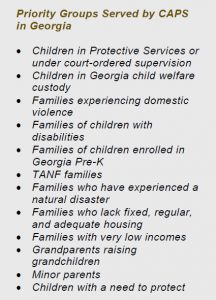 The infusion of federal funds enabled Georgia to take several steps forward in improving access to affordable child care, but Congress does not act alone to support the program. State lawmakers also raised Georgia’s investment in affordable child care by 10 percent since 2018, from $55 million to $62 million in state fiscal year 2020 that begins July 1st, 2019.[13]
The infusion of federal funds enabled Georgia to take several steps forward in improving access to affordable child care, but Congress does not act alone to support the program. State lawmakers also raised Georgia’s investment in affordable child care by 10 percent since 2018, from $55 million to $62 million in state fiscal year 2020 that begins July 1st, 2019.[13]
With this strong foundation in place, lawmakers can build on the financial investment and attention to program effectiveness by agency leaders by expanding access to the CAPS program, but the need for child care subsidies among low-income families continues to outpace funding. Given the limited availability of funds, DECAL has prioritized CAPS recipients who fall into select priority groups.[14] Under the current funding levels, DECAL sets a goal to serve 50,000 children annually in CAPS, which is only a fraction of the 364,000 children in families with low-incomes that potentially need quality and affordable child care.
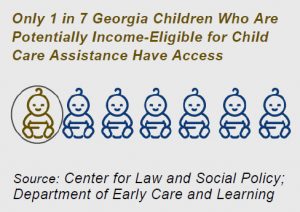 Without higher federal and state funding levels, Georgia will continue to serve approximately 50,000 children, potentially leaving out hundreds of thousands of families who would otherwise qualify for some financial support to help cover the high costs of child care. By appropriating more permanent state and federal funds, lawmakers can help DECAL balance the need to serve additional working families while also enabling the agency to adequately fund key quality initiatives.
Without higher federal and state funding levels, Georgia will continue to serve approximately 50,000 children, potentially leaving out hundreds of thousands of families who would otherwise qualify for some financial support to help cover the high costs of child care. By appropriating more permanent state and federal funds, lawmakers can help DECAL balance the need to serve additional working families while also enabling the agency to adequately fund key quality initiatives.
CCDF, State Funds Crucial for Improving Racial & Ethnic Equity
Children of color are a rapidly growing segment of Georgia’s child population, but face some of the largest systemic barriers to educational and economic well-being in the state. Improving access to child care for children of color, particularly in their early years, has a significant impact on their futures as healthy and economically secure adults and is a promising approach to eliminate stubborn racial disparities.
Young black children have the highest rate of participation in CAPS, making up 77 percent of children enrolled.[15] This affirms how important affordable child care is for eliminating barriers to work and education for black families. Black children account for half of all children that live in families with incomes below the federal poverty level in Georgia.[16]
The amount of state and federal funding currently available requires the agency to keep enrollment in CAPS limited, which has a greater impact on children of color in Georgia. The longer Georgia has to limit CAPS enrollment to eligible working families in select priority groups, the more difficult it will become to advance racial equity without leaving some families of color behind.
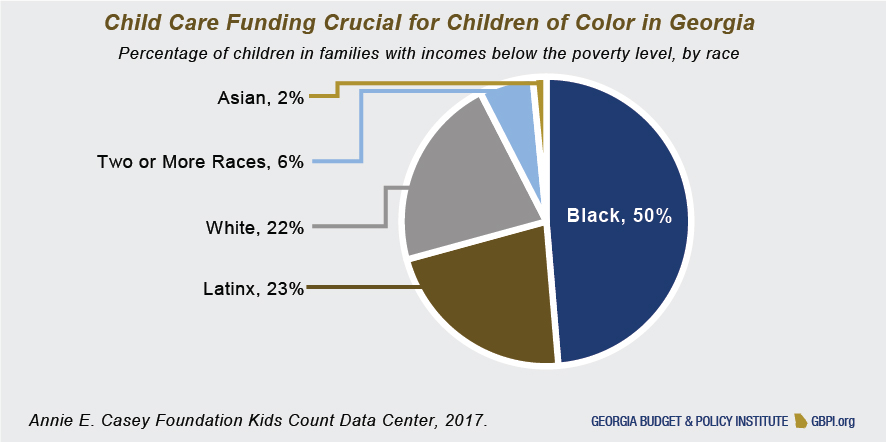 Conclusion
Conclusion
New CCDF funding allocations have positioned Georgia to accelerate efforts that strengthen the safety and quality of child care while making it more affordable for working families. But all of the positive plans resulting from the latest increase in CCDF mostly applies to a very small share of Georgia’s families. To date, the amount of funding available limits access to potentially hundreds of thousands of children that may be in need of child care. Permanently raising the state and federal funding allocation levels for CCDF in future years will allow Georgia to widen access to the child care subsidy program to serve a greater number of families while continuing to build a robust and affordable industry of high-quality child care providers.
Acknowledgements
The Georgia Budget and Policy Institute would like to thank the Georgia Department of Early Care and Learning (DECAL) and the Georgia Early Education Alliance for Ready Students (GEEARS) for providing technical comments for this policy brief.
Endnotes
[1] According to the Center for Law and Social Policy (CLASP), potentially 364,000 children are eligible for child care assistance under Georgia’s state eligibility rules but do not participate in the program. State eligibility rules defined by CLASP include child age, household income, and labor force status of the parents, meaning that the “potentially eligible figure” is a rough estimate. It is important to note that program eligibility for CAPS includes many additional variables. For CLASP methodology, visit: https://www.clasp.org/sites/default/files/publications/2019/04/2019_inequitableaccess.pdffor Georgia’s CAPS eligibility policies, visit: https://caps.decal.ga.gov/assets/downloads/CAPS/06-CAPS_Policy-Eligibility%20Requirements.pdf
[2] Georgia’s CCDF Grant Fund Spending Plan Summary. 2018. http://decal.ga.gov/documents/attachments/CCDF%20GRANT%20FUND%20SPENDING%20PLAN%20SUMMARY%20FINAL%20handout.pdf
[3] The dollar amounts listed for each spending activity represent estimates provided by the Georgia Department of Early Care and Learning.
[4] Georgia Market Rate Survey, 2017. http://decal.ga.gov/documents/attachments/GAMarketRateSurvey_Final_062817_revAug.pdf
[5] According to DECAL: “Quality Rated is Georgia’s system to determine, improve, and communicate the quality of programs that provide child care. Similar to rating systems for restaurants and hotels, Quality Rated assigns one, two or three stars to early education and school-age care programs that meet or exceed the minimum state requirements. By participating in Georgia’s voluntary Quality Rated program, programs make a commitment to work continuously to improve the quality of care they provide to children and families.” http://families.decal.ga.gov/ChildCare/QualityRated
[6] Georgia raised reimbursement rates for higher-quality providers July 2013. Child care providers that participate in the state’s voluntary Quality Rated program receive a star rating, with three stars reserved for Georgia’s highest quality providers
[7] Quality Rated eligible providers must be star rated by December 31, 2020, to participate in the CAPS program
[8] CAPS Policy
[9] Child Care Development Fund Final Rule Frequently Asked Questions. 2016. https://www.acf.hhs.gov/occ/resource/ccdf-final-rule-faq
[10] Georgia’s CCDF Grant Fund Spending Plan Summary. 2018. http://decal.ga.gov/documents/attachments/CCDF%20GRANT%20FUND%20SPENDING%20PLAN%20SUMMARY%20FINAL%20handout.pdf
[11] Child Care Development Fund Final Rule Frequently Asked Questions. 2016. https://www.acf.hhs.gov/occ/resource/ccdf-final-rule-faq
[12] Quality Rated Subsidy Grants Program Application Webinar. Department of Early Care and Learning. 2015. http://decal.ga.gov/documents/attachments/QRSubsidyGrantAppFall.pdf
[13] In state fiscal year 2018, the legislature approved a $5.9 million increase in state funding for child care. In state fiscal year 2020, the legislature added an additional $500,000 for child care assistance.
[14] CAPS Policy – Priority Groups. Georgia Department of Early Care and Learning. 2019.
[15] Georgia Department of Early Care and Learning, 2018
[16] Annie E. Casey Foundation Kids Count Data Center, 2017.









